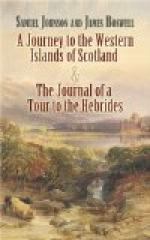The peculiarities which strike the native of a commercial country, proceeded in a great measure from the want of money. To the servants and dependents that were not domesticks, and if an estimate be made from the capacity of any of their old houses which I have seen, their domesticks could have been but few, were appropriated certain portions of land for their support. Macdonald has a piece of ground yet, called the Bards or Senachies field. When a beef was killed for the house, particular parts were claimed as fees by the several officers, or workmen. What was the right of each I have not learned. The head belonged to the smith, and the udder of a cow to the piper: the weaver had likewise his particular part; and so many pieces followed these prescriptive claims, that the Laird’s was at last but little.
The payment of rent in kind has been so long disused in England, that it is totally forgotten. It was practised very lately in the Hebrides, and probably still continues, not only in St. Kilda, where money is not yet known, but in others of the smaller and remoter Islands. It were perhaps to be desired, that no change in this particular should have been made. When the Laird could only eat the produce of his lands, he was under the necessity of residing upon them; and when the tenant could not convert his stock into more portable riches, he could never be tempted away from his farm, from the only place where he could be wealthy. Money confounds subordination, by overpowering the distinctions of rank and birth, and weakens authority by supplying power of resistance, or expedients for escape. The feudal system is formed for a nation employed in agriculture, and has never long kept its hold where gold and silver have become common.
Their arms were anciently the Glaymore, or great two-handed sword, and afterwards the two-edged sword and target, or buckler, which was sustained on the left arm. In the midst of the target, which was made of wood, covered with leather, and studded with nails, a slender lance, about two feet long, was sometimes fixed; it was heavy and cumberous, and accordingly has for some time past been gradually laid aside. Very few targets were at Culloden. The dirk, or broad dagger, I am afraid, was of more use in private quarrels than in battles. The Lochaber-ax is only a slight alteration of the old English bill.
After all that has been said of the force and terrour of the Highland sword, I could not find that the art of defence was any part of common education. The gentlemen were perhaps sometimes skilful gladiators, but the common men had no other powers than those of violence and courage. Yet it is well known, that the onset of the Highlanders was very formidable. As an army cannot consist of philosophers, a panick is easily excited by any unwonted mode of annoyance. New dangers are naturally magnified; and men accustomed only to exchange bullets at a distance, and rather to hear their enemies than see them, are discouraged and amazed when they find themselves encountered hand to hand, and catch the gleam of steel flashing in their faces.




